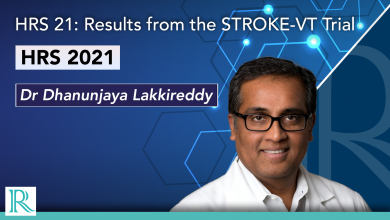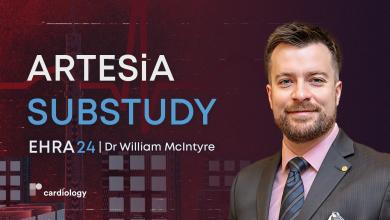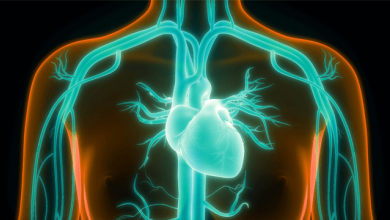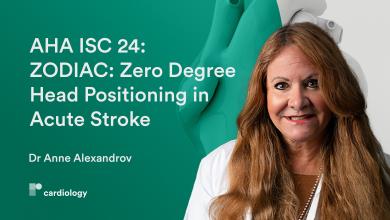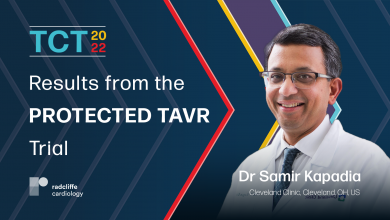Search results
Start date:
Feb 07, 2024
End date:
Feb 09, 2024
Register Now!Join us for the International Stroke Conference 2024 in Phoenix, Arizona. This is your opportunity to:Network with fellow professionals.Stay updated on the latest treatments and scientific breakthroughs.Collaborate with global experts.Dive into discussions on brain health, stroke recovery, and more.Don't miss out! Register today and be part of ISC 2024.Find the online program planner…
View more
Author(s):
Dhanunjaya Lakkireddy
Added:
2 years ago
Dr Dhanunjaya Lakkireddy (Kansas City Heart Rhythm Institute, Overland Park, KS, US) sits down to discuss the findings of the STROKE-VT Trial, which investigated the use of aipaxaban in reducing blood clots and stroke risk after an ablation procedure.
Questions:
1. Please summarise the aim, study design and endpoints?
2. What were your major findings?
3. What further research is required?
4…
View more
Author(s):
Praveen Rao
,
Olusegun Olusesi
,
Mitchell Faddis
Added:
3 years ago
It is presumed that the pathogenesis of stroke in atrial fibrillation (AF) patients is due to embolization of thrombus from the left atrium. Within the left atrium, the left atrial appendage is the predominant site of thrombus formation. In a study of 233 patients with new onset AF of greater than 48 hours in duration who were not anticoagulated, left atrial appendage thrombus was present in 15 %…
View more
Author(s):
William McIntyre
Added:
1 week ago
EHRA 24 - Investigator, Dr William McIntyre (Population Health Research Institute, CA) joins us to discuss the findings from a substudy of ARTESiA (NCT01938248).ARTESiA was a randomized, parallel assignment clinical trial which aimed to assess if apixaban could reduce the risk of ischemic stroke and systemic embolism in patients with subclinical atrial fibrillation (AF) and additional risk…
View more
Author(s):
Christopher J White
Added:
3 years ago
More than three-quarters of a million Americans will suffer a stroke this year. Stroke ranks as the third most common cause of death after heart disease and cancer. It is the number one cause of disability among adults and the main reason for rehabilitation. Many, but not all, strokes are related to atherosclerosisÔÇöthe same disease that causes heart attacks. Blockage of one of the two main…
View more
Author(s):
Christopher J White
Added:
3 years ago
More than three-quarters of a million Americans will suffer a stroke this year. Stroke ranks as the third most common cause of death after heart disease and cancer. It is the number one cause of disability among adults and the main reason for rehabilitation. Many, but not all, strokes are related to atherosclerosisÔÇöthe same disease that causes heart attacks. Blockage of one of the two main…
View more
Author(s):
Raymond B Fohtung
,
Michael W Rich
Added:
3 years ago
Atrial fibrillation (AF) is the most common clinically significant arrhythmia, with an overall prevalence of approximately 1 % in the general population.1 An estimated 2.3 million adults in the US have AF, and this number is projected to increase to 5.6 million by 2050.1 The most clinically important complication from AF lies in the risk for cardiac thrombus formation and systemic embolism…
View more
Author(s):
Anne Alexandrov
Added:
1 month ago
AHA ISC 2024 — Dr Anne Alexandrov (University of Tennessee Health Science Center, US) joins us to summarise the key findings from the Zero Degree Head Positioning in Hyperacute Large Artery Ischaemic Stroke (ZODIAC) trial (NCT03728738).ZODIAC is a prospective randomized open blinded endpoint (PROBE) clinical trial investigating head positioning in hyperacute LVO ischemic stroke treatment. It aims…
View more
Author(s):
Samir R Kapadia
Added:
1 year ago
TCT 22 - In this short interview, Dr Samir Kapadia (Cleveland Clinic, OH, US) outlines the findings of the PROTECTED-TAVR trial, which aimed to demonstrate the performance of Boston Scientific's Sentinel® Cerebral Protection System in transcatheter aortic valve replacement.
In this study, 3000 patients were randomized to receive either TAVR with the Sentinel system or TAVR without intervention…
View more
Left Atrial Appendage Closure Devices for Stroke Prevention in Patients with Non-Valvular AF
Author(s):
Daniel A McBride
,
Timothy M Markman
,
Jackson J Liang
,
et al
Added:
3 years ago
Article









